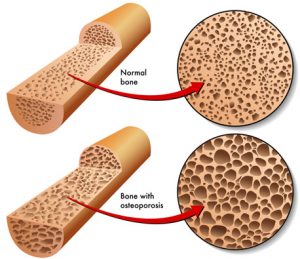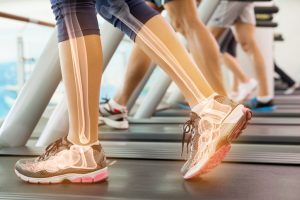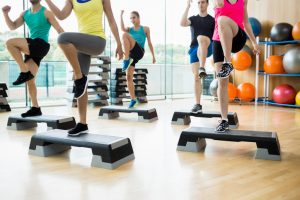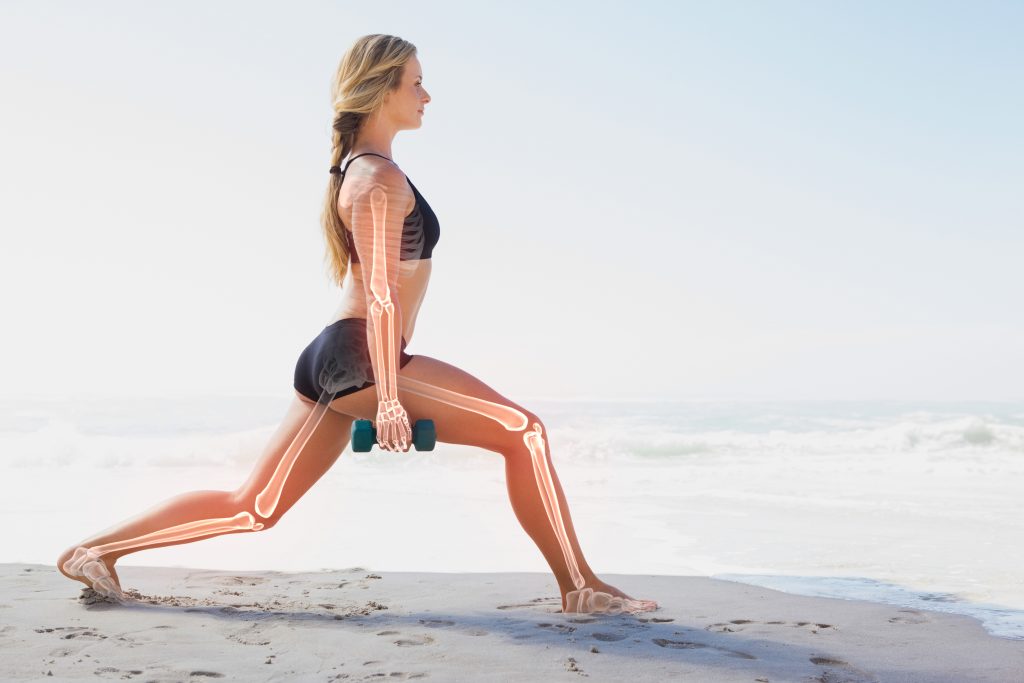Bone health is a growing area of research, and osteoporosis, in particular, is becoming a growing public health problem. Maintaining bone health is the most effective way to prevent osteoporosis. This post covers how to use diet and exercise to keep your bones healthy.
Diet and Exercise to Prevent Osteoporosis
There are many reasons to exercise and eat well. However, there are less well-known benefits. A good diet and the right forms of exercise increase bone density. Improving your bone density helps prevent osteoporosis.
What is Osteoporosis?
Osteoporosis is a skeletal disorder. Bones become weak and fracture easily. Bone fractures can be incapacitating, and often lead to loss of mobility.

Osteoporosis is most common in post-menopausal women. However, it can affect anyone at any age. People that may be of increased risk include:
- Elderly people.
- Women during and after menopause. As women get closer to menopause, the ovaries produce less oestrogen. Reductions in oestrogen cause your bone cells to break down.
- Men with low levels of testosterone.
- People of Caucasian or Asian ethnicity.
- Smaller boned and thin people.
- Smokers and alcohol users. Smoking increases the risk of osteoporosis because it weakens bones. It also lowers oestrogen levels. Furthermore, alcohol makes it harder to absorb calcium from foods.
- People with a sedentary lifestyle. Doing exercise slows the rate of bone loss. It increases muscle mass, and also helps to improve balance.
- People lacking in calcium and vitamin D. Calcium is essential to good bone health. Without vitamin D, we cannot absorb calcium.
- People using certain medications and/or with specific medical conditions. If you’re concerned, it is best to speak to your GP.
- People with a family history of Osteoporosis.
If you fall into any of these categories, you especially need to look after your bones. However, good bone health is beneficial to everyone. Unfortunately, most people don’t realise they have osteoporosis until a fracture occurs. We will first cover how to determine if you are at increased risk. Then we will look at the best types of foods and exercise to prevent osteoporosis.
Bone Density Tests to Prevent Osteoporosis
Bone density tests are called DXA or DEXA scans. These assess your risk of bone fractures. Having a bone density test can help identify signs of osteoporosis early on. Bone density tests are usually only given to women over 65. They can only detect signs of osteoporosis once they are already present. It is also harder to improve bone density the older you are.
However, there is plenty you can do right now to maintain your bone health. The right eating and exercise habits can help prevent osteoporosis in the future. The earlier you can begin looking after your bones, the better!
The Right Diet for Bone Health
As you grow older, your bone density reduces. Ensuring your bones are in the best health right now is a way to prevent osteoporosis later on.

Some practical ways to maintain bone health include:
- Eating a generally healthy and balanced diet. Include fruit, vegetables, grains, lean meats, and dairy in your diet. Cut back on sugar, fat and processed foods. Doing this has been shown to improve bone health. (Movassagh and Vatanparast, 2017)
- Increasing your calcium intake. Calcium helps to build and keep strong bones. Current guidelines state that people aged 31-50 should have an intake of 1,200mg a day. People over 50 should aim slightly higher – between 1,200 to 1,500mg.
- Increasing your vitamin D intake. The body uses vitamin D3 to absorb calcium. Increase your vitamin D intake by consuming more eggs and oily fish. Fortified cereals and milk are also good sources. Another simple way of increasing vitamin D is through supplements.
- Cutting back on caffeine. Too much caffeine can result in lower calcium levels.
- Moderating your alcohol consumption. The advised maximum allowance of alcohol is 14 units a week. This is as little as 6 pints of beer or 10 glasses of low-strength wine (NHS, 2018). Overconsuming alcohol results in an imbalance of calcium in your body. It also changes the way our bodies make the hormones and vitamins required for healthy bones.
Exercise to Prevent Osteoporosis
Any weight-bearing exercise helps to prevent osteoporosis. This is because it improves bone density. Weight-bearing exercise covers any physical activity done on your feet. This helps strengthen bones because it requires them to work against gravity. Your bones have to react to the weight put on them, which helps to make them stronger.

Weight-bearing exercise works through applying mechanical force to the bone. This force causes microfractures. These microfractures stimulate increased activity in cells that make new bone (Carter, 1984). Therefore introducing stress to the skeleton helps build stronger bones.
Resistance Training and Bone Health
There are many types of weight-bearing exercise. There are many types of weight-bearing exercise. Resistance training is the most effective for maintaining bone health. This is because it involves greater mechanical force. Mechanical force encourages new bone cells to grow (Kurabayashi, 2017). The stronger your bones, the more likely it is that you can prevent osteoporosis.
Many resistance training moves target the areas most prone to fractures. These include the hips, spine and also the wrists. I’ve chosen the ones below because they focus on all of these areas. You can do these exercises with added weight, or just using your bodyweight.
Resistance Training Exercises to Prevent Osteoporosis
- Squats. There are many different forms of squats. The traditional barbell back squat is a great option. But this takes experience or guidance from a personal trainer. Alternatively, you can squat holding a dumbbell in front of your chest. You could also use an exercise ball against the wall.
- Lunges. Lunges involve engaging the muscles around your hips and legs. Balancing on one leg can help improve bone density. You can increase the load further by using a barbell, dumbbell or weighted medicine ball.
- Step-ups. Step ups engage similar muscles to lunges. A step-up requires you to use one leg to propel your body weight in the air. You can do step ups anywhere. Try using a bench, low wall, chair, or an exercise step in the gym. You can regress or progress step ups. For more of a challenge, adjust the height of the platform, or add weight.
- Press-ups. Press-ups are great for improving the strength in your wrists. They’re also useful for increasing core strength. Make press-ups easier by doing them on your knees. Or you could also try them against a work surface or wall. To make them harder, try adding weight. You can do this by wearing a weighted vest or putting a weight plate on your back.
Other Weight-Bearing Exercises to Prevent Osteoporosis
Resistance training isn’t for everyone. It often requires some level of experience in a gym. It also requires the right equipment. But weight-bearing exercise doesn’t need to be about heavy lifting. Nor do you need to push yourself to your limit.

Weight-bearing aerobic exercise is also beneficial in maintaining bone health. This type of activity may be better suited to those who don’t have access to a gym. There is also less of a safety risk involved in aerobic exercise. All weight-bearing exercise applies force to your bones. So you can still prevent osteoporosis without lifting weights.
There are two different types of weight-bearing aerobic exercise. High impact exercises include:
- Brisk walking
- Dancing
- Jogging
- Skipping
- Step aerobics
- Racquet sports
If you are at risk of fragile bones, high-impact activities may not be safe. You can still strengthen your bones using low-impact exercises. These include:
- Elliptical machines
- Low impact aerobics
- Stair climber machine
- Walking
- Muscle strengthening exercises
Weight-bearing exercise can be adapted for all abilities. It’s about finding the right type to suit you. Because of the bone-strengthening effect, a weight-bearing exercise program can help prevent osteoporosis.
Prevent Osteoporosis Through Diet and Exercise
A healthy diet and regular weight-bearing exercise can help prevent osteoporosis. This is because of their effect on bone density. Therefore the earlier you start, the more you can prevent osteoporosis later in life. This is especially true if you fall into one of the high-risk groups.
To ensure your diet is bone-health friendly, reduce your caffeine and alcohol intake. Increase your calcium and vitamin D intake. Also, avoid added sugar and saturated fat. Most importantly, quit smoking! Aim to do 30 minutes of weight-bearing exercise a day. Resistance training is the most effective in improving bone density. However, there are also many other types of weight-bearing exercise. Find the right form of exercise to suit your lifestyle, because consistency is key.

Osteoporosis is becoming a real public health problem. Therefore it’s increasingly important to improve bone health. People don’t usually realise they have osteoporosis until they begin developing bone fractures. This is because it is hard to detect without a bone density test. But it is preventable. So start looking after your bones today to prevent osteoporosis later in life.
Now you know how exercise helps your bones, why not find out about what happens to muscles when you exercise?
